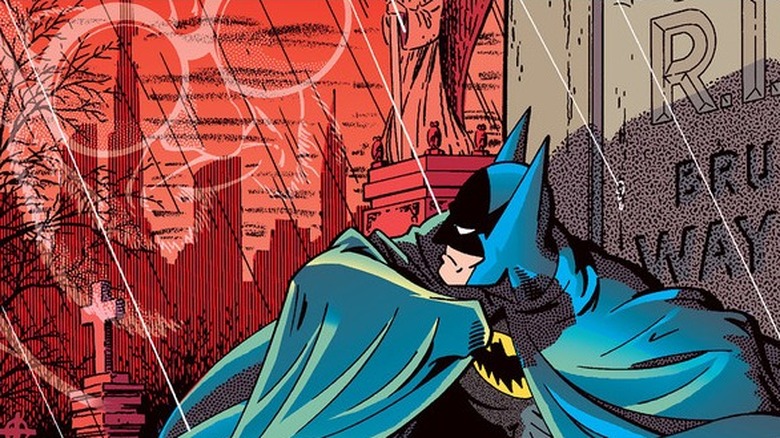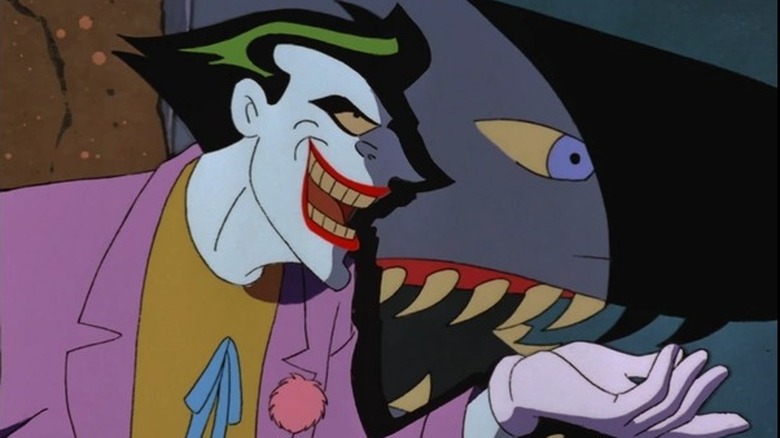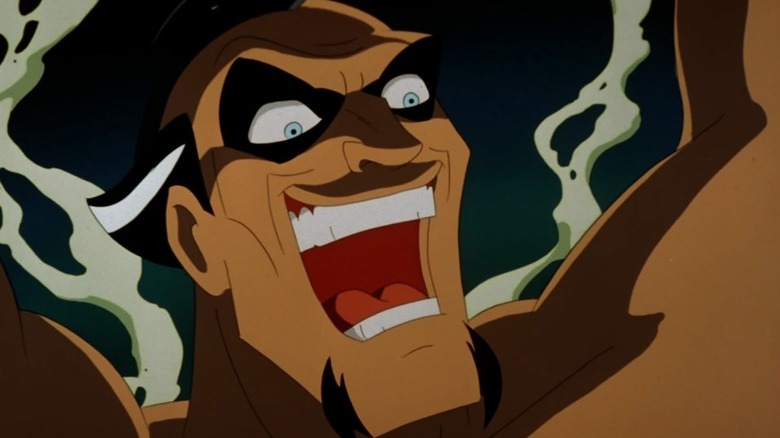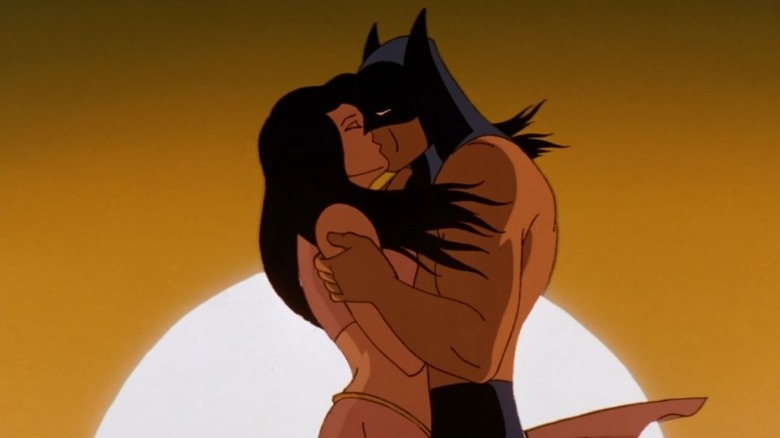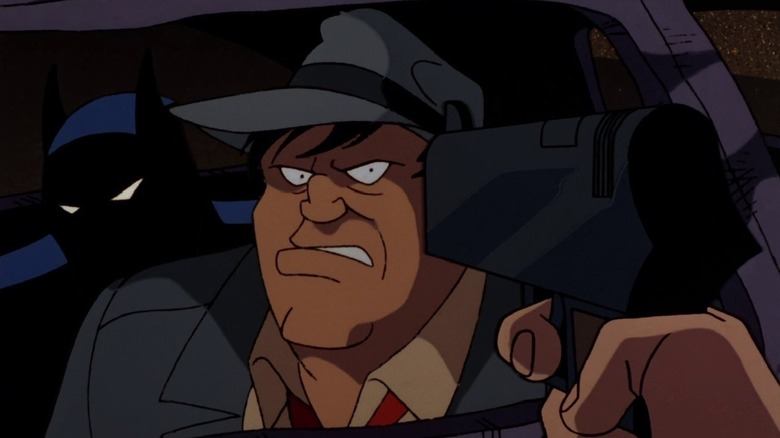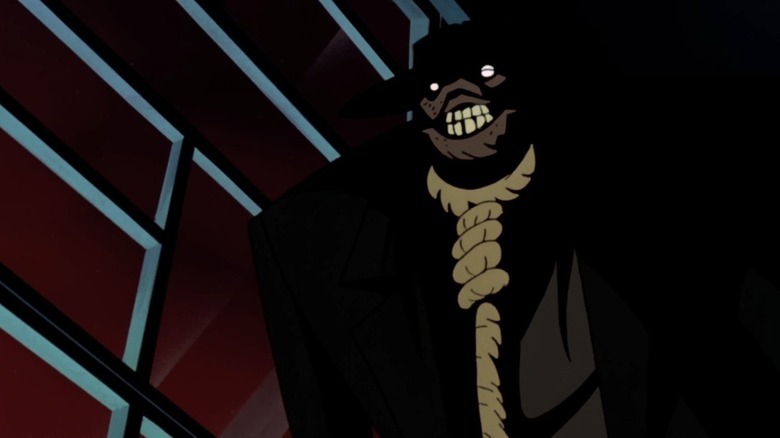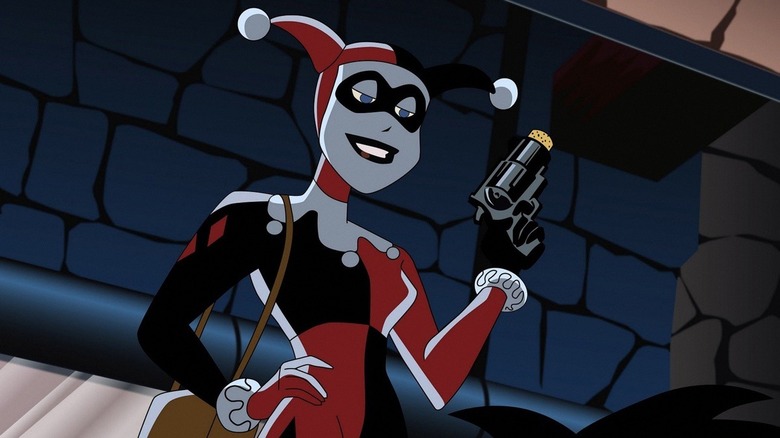How Batman: The Animated Series Managed To Stay Faithful To Its Comic Book Counterpart
"Batman: The Animated Series" perfectly captured the essence of its comic source material, from the costumed characters of Gotham City to the personality of the metropolis itself. However, it only occasionally adapted comic storylines. Compared to the contemporaneous "X-Men" cartoon which slavishly recreated comic arcs, the "Batman" creative team was more comfortable putting their own spin on things. That's how Harley Quinn was born, after all.
The series did directly adapt from the comics on occasion, but even that came with stipulations. Paul Dini, the series' head writer and producer (not to mention the creator of the aforementioned Miss Quinn) had this to say in issue #99 of "Back Issue magazine:
"It's hard to adapt a comic directly for animation. The storytelling and pacing are different, and there might be other elements like excessive dialogue or graphic violence that don't translate well from one medium to the other. In the case of the Batman stories we adapted, we took elements from the comic book that made a great story and reworked them to fit the pace and tone of our series. It was a matter of knowing what to cut and what to save, and what to rework, to best suit our own versions of the iconic characters."
Here are some examples of the most direct adaptations in "Batman: The Animated Series," and the changes the show's team still had to make to them.
The Laughing Fish
Steve Englehart and Marshall Rogers' run on "Detective Comics" may have been only eight issues (#469–476), but its influence hung over "Batman: The Animated Series." With the character of Silver St. Cloud, the story questioned if Batman could find love while leading his double life. That same question is at the heart of the animated film, "Batman: Mask of the Phantasm."
A more literal adaptation comes in "The Laughing Fish," the title of both issue #475 and "Batman: The Animated Series" episode 46. Both versions feature the Joker using his laughing gas on the fish in Gotham Harbor and then trying to patent the likeness; he resorts to murdering copyright clerks when that fails.
The animated "The Laughing Fish" is actually a combination of the eponymous comic and an earlier one, "Joker's Five Way Revenge." Published in "Batman #251," that story features the Joker killing five of his former henchmen, one by one, after one of them ratted on him. "Five Way Revenge" would be too gruesome to wholly adapt in a kids' cartoon, but Paul Dini found a use for its aquarium-set third act (where Batman wrestles with a shark) in "The Laughing Fish."
Dan Riba, a director on the series, told Back-Issue: "the original ['Laughing Fish'] story was part of a bigger serialized arc. To adapt it to a film story it needed a bigger resolution [...] [Dini] basically took the ending of one, popped it on the other, and now you have a show."
This was a natural edit — there's no better punchline to the Joker's fishy scheme than Batman fighting the deadliest fish in the sea.
Demon's Quest Part 1
The other Batman comics which influenced "Batman: The Animated Series" were those crafted by Dennis O'Neil and Neal Adams. Before Englehart/Rogers came along, this duo kickstarted the more serious tone of Batman comics. They also introduced Ra's Al Ghul, his daughter Talia, and the League of Assassins to Batman's world. "Batman: The Animated Series" followed suit by bringing these characters outside comics for the first time.
The episode "Off-Balance" loosely adapts "Detective Comics" #411, where Batman first meets Talia while fighting a rogue Assassin (Dr. Ebenezer Darrk in the comic, a reimagined Count Vertigo in the episode). The episode takes its liberties, but one moment replicated exactly is when Batman awakens and finds Talia has unmasked him while he was unconscious. Unlike the comic, the episode directly sets up Ra's Al Ghul with an added scene of Talia reporting on the events to her father.
Batman and Ra's clash came in the two-part episode "The Demon's Quest." "Part 1" directly adapts "Batman" #232: both Robin and Talia are kidnapped, so Batman and Ra's team up, trekking across the globe in search of them. It turns out Ra's masterminded the whole thing to see Batman in action and determine if the Dark Knight could be a worthy heir.
Demon's Quest Part 2
Dennis O'Neil himself wrote the script for "Part 1," later telling Back-Issue:
"I thought, 'OK, I've got me a 22-page comic book, and the TV show's about 20 minutes. This is going to be a piece of cake.' And I found that if I had done my comic-book story literally, I would have run out of material before that 20-minute mark. So, trying to be a reasonably disciplined professional, my job became to invent new scenes that looked like they were part of the original."
One such new scene features Ra's telling Batman of his goal to "save the world" by wiping out most of its population. This not only fleshes out the villain, but it also sets up "Part 2" (written by Len Wein).
"Part 2" adapts "Batman" #243 to 244, three scenes in particular. One, Ra's bathing in the youth-restoring Lazarus Pit. Second, the Dark Knight and the Demon's Head have a shirtless duel in the desert. Third, Batman and Talia's bittersweet goodbye after he defeats her father. However, the episode adds higher stakes. In the comic, Batman simply has to defeat Ra's mano-a-mano. In the episode, he also has to stop Ra's plan to wipe out the world's population.
As with "The Laughing Fish," "The Demon's Quest" took overlapping stories, merged them into a cohesive whole, and crafted a climax worthy of animation.
A Bullet for Bullock
While "Batman: The Animated Series" was mostly inspired by the Batman comics of the 1970s and 80s, it did adapt a contemporaneous comic with "A Bullet for Bullock." Said episode was based on (and named after) "Detective Comics #651." Written by Chuck Dixon and penciled by Graham Nolan, the issue was published in 1992, the same year "The Animated Series" debuted.
Detective Harvey Bullock was a recurring character in Batman stories, mostly acting as a foil for Commissioner Gordon, i.e. a crude, not-so-upright cop who distrusts Batman. Considering his regular presence in "Batman: The Animated Series," it makes sense the show adapted a comic story centered on him. "A Bullet for Bullock" sheds light on his character when Batman investigates attempts on Bullock's life. It turns out the wannabe killer wasn't a criminal Bullock once busted, but his landlord Nivens, who was sick of having such a lousy tenant.
Written by Michael Reaves, the episode script follows the same beats as the comic and adapts some scenes almost word-for-word, such as Batman and Bullock's first rooftop meeting. There were some changes, though, and Paul Dini's words about how to change a comic story to an episode ring true.
The episode removes Harvey's narration (which works in a written medium, but not an audiovisual one), setting the mood with jazz music instead. Then there's the issue of inappropriate content: instead of Bullock blowing cigar smoke in Nivens' face like in the comic, he flicks his toothpick at him. To fill out time, the episode adds some conflict between Batman and Bullock and a scene of the latter antagonizing Gotham reporter Summer Gleeson.
The comic also plays the final twist as a punchline (Bullock jokes, "I was thinking of moving anyway"), but in the episode, it's a condemnation of his behavior.
More adaptations
Often "Batman: The Animated Series" would take the simple premise of a comic story and weave something new. "Sideshow" adapts Dennis O'Neil's "Detective Comics #410," about Batman pursuing an escaped inmate hiding out with carnival freaks. The episode replaces the comic's one-off villain with Killer Croc, a natural fit since he's of a kind with the "freaks." "The Strange Secret of Bruce Wayne" takes from the Englehart/Rogers run, where Hugo Strange tries to auction off Batman's secret identity to Gotham's super-villain. However, the rest of the story is different and the animated Strange is a less formidable adversary than the comic one.
This trend continued over even when the series rebranded as "The New Batman Adventures" for season 4. "Never Fear" took the premise of "Detective Comics" #571 (by Mike Barr and Alan Davis): the Scarecrow invents a new drug that removes one's fear and while trying to stop him, Batman gets dosed with it. In the comic story, "Fear For $ale," Scarecrow abducts Robin and Batman has to save his sidekick despite having no inhibitions. From there, it's business as usual: Batman busts into Scarecrow's hideout, avoids the death traps, and saves Robin. "Never Fear" does something more character-driven and, frankly, much better. While under the drug's influence, Batman is no longer afraid to use lethal force. Robin becomes the episode's hero: he has to stop Scarecrow's scheme and stop Batman from killing the villain.
"Joker's Millions" also adapted the eponymous story from 1952's Detective Comics #180. To meld the comic's Silver Age camp with the show's serious tone, the episode turned the story into an outright comedy. It also added new scenes with Harley Quinn, in particular a satisfying ending where she beats Joker with a club for leaving her in Arkham.
Speaking of Harley...
Mad Love
Everything came full circle for one of the last episodes of "Batman: The Animated Series" — Paul Dini adapted his own comic, "Mad Love," into animation. After Dini created Harley Quinn, he realized he'd struck gold and so rescued her from just being a one-off villain. In 1994, he wrote "Mad Love" for the show's recursive spin-off comic "Batman Adventures." The story revealed Harley's origin as she tries to kill Batman herself, so she and "Mistah J" can be happy in a Caped Crusader-free world.
The episode tones down the comic's content, removing some swear words (mostly from the Joker), sexuality (it goes unmentioned how Harley slept with professors to pass college), and surreality (when Harley imagines her and the Joker raising a family or growing old together). However, it's otherwise a scene-for-scene recreation, not surprising since Dini was retelling his own story.
Harley's love for the Joker is delusional, but the affection the creators of "Batman: The Animated Series" had for their characters and comic source material is all true. That love is why even when they rearranged the details of comic stories, they were still careful to capture their essence.
